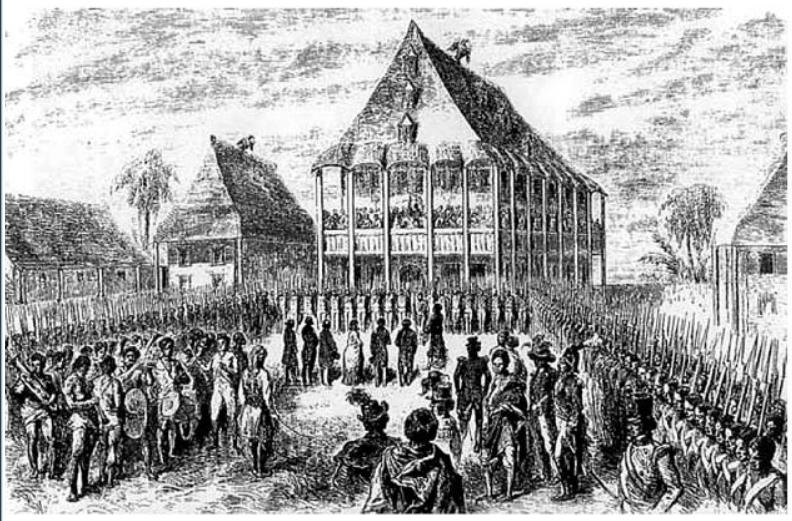
Jean Laborde: A historic figure in Madagascar
In the 1830s, Jean Laborde, a self-made Frenchman of Gascon origin, gained the trust of Queen Ranavalona I and was tasked with manufacturing rifles and cannons for the Malagasy army, as well as industrializing the country. He is even rumored to have become the queen’s lover. His accomplishments, including the artificial lake of Mantasoa, are now part of Madagascar’s heritage.
Jean Laborde: An ambitious youth and adventurer
Jean Laborde was born in Auch on October 16, 1805, under circumstances that did not predict his rise to historical prominence in Madagascar. At school, he was far from exceptional, and his future seemed uninspiring. His father taught him the trade of blacksmithing, but the ambitious young Laborde knew he would not inherit the family business since he was not the eldest son. He decided to join a regiment of dragoons (mounted soldiers), achieving the rank of sergeant major by the age of 22.
In July 1827, he informed his father that he intended to seek his fortune in the Indies. For him, this was a way to change his destiny, as the France of the Restoration era offered little opportunity for his ambitions. Upon arriving, he successfully sold his father’s gifted bundle of trinkets and established his own trading post. Over three years, he proved skilled in business: shrewd, confident, and energetic. His largest deal was manufacturing 300 trumpets for a Maharajah.
However, in 1831, he abandoned everything to embark on a treasure hunt in the Mozambique Channel, purchasing the Saint Roch from a Savoyard captain without resources or command. At 26, thirsting for fortune, Laborde spent seven months at sea searching fruitlessly for treasure before his ship ran aground on Madagascar’s eastern coast near Sainte-Marie Island. Struck by a storm, the vessel lost its lifeboats, nearly killing the crew, who were saved by Laborde’s bravery as he jumped into the sea with a long rope to guide the others.
Jean Laborde: An industrialist and influential figure
Shipwrecked at the mouth of the Matitanana River (near Vohipeno), Laborde lost everything, including his ship, which shattered on the rocks. Local inhabitants found him and his crew and, instead of killing them, brought them to a vazaha (a white foreigner) 180 km inland on foot. This vazaha was Napoléon De Lastelle, a wealthy French businessman who ran a sugarcane plantation and traded cattle and slaves with the islands of Bourbon (Réunion) and Mauritius, under Queen Ranavalona I’s permission. At the time, Europeans were far from welcome.
De Lastelle offered Jean Laborde a job in his sugar factory and quickly recognized his talents. Laborde proved to be hardworking and ingenious, able to repair any machine and skilled in blacksmithing. De Lastelle sent him to meet the queen to secure a contract for manufacturing rifles for the Malagasy army. Although Ranavalona I already had an agreement with a man named Jolycœur, he seemed incapable of fulfilling it.
After a long wait and navigating a complex protocol, Jean Laborde reached Antananarivo and met the queen, whom the French would later nickname “the female Caligula.” She was reportedly charmed by the young man, 17 years her junior, and awarded him the rifle manufacturing contract, along with much more. Forging, foundry work, paper production, pottery, glassmaking—Laborde was entrusted with the country’s industrialization. This ambitious Gascon had finally found his Eldorado, becoming a powerful industrialist and a highly influential figure close to Malagasy royalty.

Jean Laborde: A husband and lover
De Lastelle arranged a marriage for Jean Laborde with Émilie Roux, a mixed-race woman. This allowed Laborde to learn the Malagasy language and integrate into the culture. As a wedding gift, De Lastelle gave him the Encyclopédie Roret, a 32-volume encyclopedia. Laborde later used it to master complex modern techniques in mechanics, industry, chemistry, and more.
However, Laborde spent much of his life far from his wife and son, Clément Laborde (born in 1833), as he remained close to the queen. In 1856, he repudiated his wife for adultery and left her to manage the Lohasaha farm.
In Jean Laborde, pour l’amour d’une reine, author Pierre Sogno portrays Laborde and Ranavalona I as both business partners and lovers. Ranavalona I was notorious for expelling English missionaries, persecuting and executing Malagasy Christians, and successfully resisting French and English invasion attempts. Though known for her cruelty, implacability, and authority, she was affectionate and sensual in the arms of her lover. Their separation seemed unlikely until the English reported a royal plot, accusing the French, including Laborde, of involvement. Laborde was exiled to La Réunion in 1857.
Jean Laborde: A consul and a symbol
During his prime, Jean Laborde built an industrial city in 1837: Mantasoa, originally Soatsimanampiovana (“the unchanging beauty”). He conceived and created an artificial lake to regulate the flow of the Ikopa River. The dams protected the Betsimisaraka plain and its rice fields from flooding. This massive 20 km² water reservoir supported workshops for carpentry, foundry work, ironwork, pottery, paper production, soap making, and more. He also built a large wooden palace on the site of King Andrianampoinimerina’s palace: the Rova of Manjakamiadana, later covered in stone by James Cameron during Ranavalona II’s reign.
After Ranavalona I’s death in 1861, Laborde returned to Madagascar and represented French diplomacy. Napoleon III appointed him as the first French consul in Madagascar. King Radama II, Ranavalona’s son, was a friend of the French and peacefully opened the country’s doors to France. However, Radama II was assassinated in his palace with his sash on May 11, 1863. With the English regaining dominance, Laborde withdrew, disillusioned.
He fell ill and died on December 27, 1878. Laborde’s body rests in a tomb in Mantasoa, which he had built for himself. The reigning queen at the time, Ranavalona III, honored him with a grand funeral. Today, every Malagasy schoolchild learns about this historical figure !